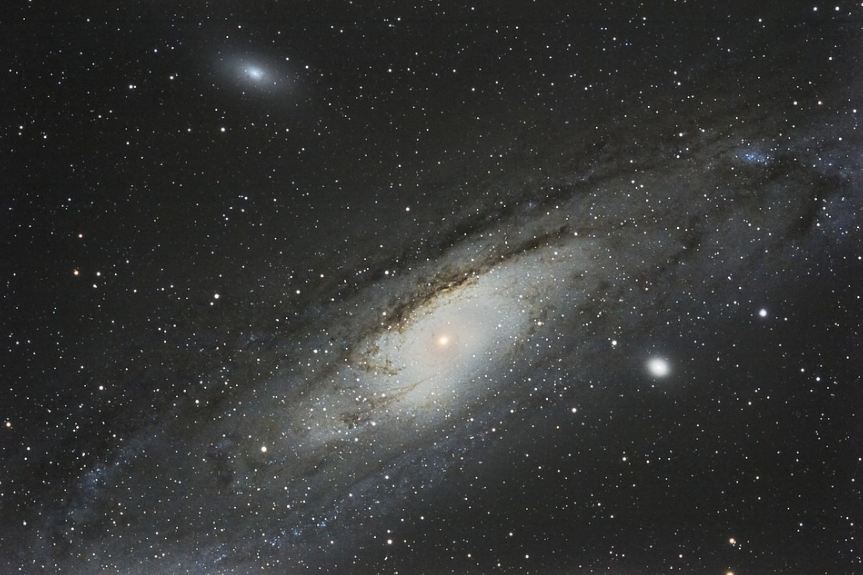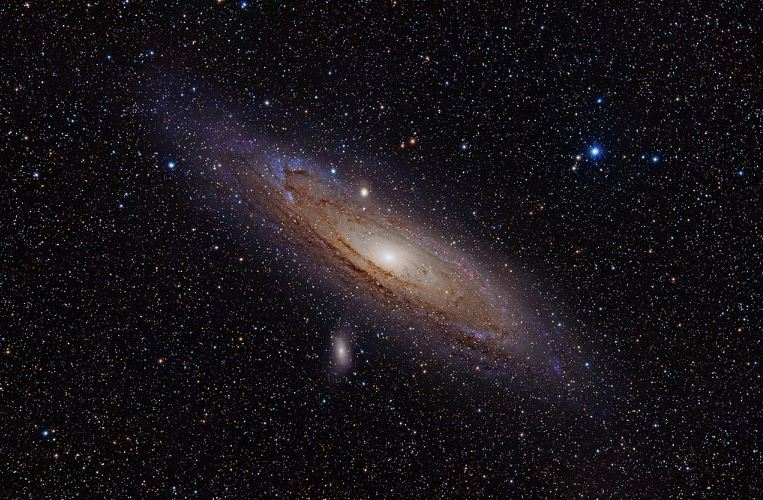Several dozen minor galaxies lie closer to the Milky Way, but the Andromeda galaxy is the nearest large spiral galaxy to it. Also known as the M31, the Andromeda Galaxy is the brightest galaxy you can see from northerly latitudes. At 2.5 million light-years, this is perhaps one of Earth’s most distant things visible to the human eye without any device used. However, if you wish to be awe-struck and inspire by its beauty, you can use any beginner telescopes or favorite handy binoculars.
This galaxy appears as a light smudge larger than a full moon. Other names for this galaxy include Messier 31, M31, or NGC 224. The galaxy got its name from the area of Earth’s sky where it appears, the constellation of Andromeda. Andromeda is also the name of an Ethiopian (or Phoenician) princess who was Perseus’s wife in Greek mythology.
Andromeda galaxy’s virial mass at 1 trillion solar masses (2.0×1042 kilograms) is of the same order of magnitude as that of the Milky Way. However, the accurate mass of either galaxy is difficult to estimate, but it was long thought that the Andromeda Galaxy is about 25%-50% more massive than the Milky Way. Although in 2018, this was questioned by a study that cited a lower estimate on the mass of the Andromeda Galaxy, combined with preliminary reports on a 2019 study estimating a higher mass of the Milky Way. The Andromeda Galaxy has a diameter of about 220,000 light-years (67 kpc), making it the largest member of the Local Group in terms of extension, if not mass.
With your Catadioptric Telescopes for Astronomy, you will be amazed by the incredible stars you can see in the Andromeda galaxy. If you will ask how many are, they? It is about at one trillion, or roughly twice the number estimated for the Milky Way.
The Milky Way and Andromeda galaxies are expected to collide, altering the structure of the two galaxies forever. They will merge into a giant elliptical galaxy or a large lenticular galaxy.
As the two galaxies move closer to one another at about 70 miles per second (112 kilometers per second), astronomers estimate after about 4.5 billion years, they will collide, and the merger is concluding 6 billion years from now. By that time, the Sun will have grown into a red giant and swallowed up the terrestrial planets. So Earth will have other things to worry about. Andromeda’s apparent magnitude of 3.4 makes it among the brightest of the Messier objects, visible to Earth’s naked eye on moonless nights, even when viewed from areas with moderate light pollution.
When to look for the Andromeda Galaxy

During late August and early September, start looking for the galaxy in mid-evening, about midway between your local nightfall and midnight. In late September and early October, it shines in the eastern sky at nightfall, swings high overhead in the middle of the night, and stands relatively high in the west at the onset of the morning dawn. Winter evenings are also suitable for viewing the Andromeda galaxy.
Using the Cassiopeia constellation, you can find the Andromeda galaxy. Cassiopeia the Queen shaped like M or W is one of the easiest constellations to recognize and locate. Just look northward on the sky’s dome. If you can identify the North Star, Polaris – and if you know how to find the Big Dipper – be aware that the Big Dipper and Cassiopeia move around Polaris like the hands of a clock, always opposite each other.
Recent Discoveries about Andromeda Galaxy
Observations from the Hubble Space Telescope in 2015 have found that a halo of material surrounding Andromeda is six times larger and 1,000 times more massive than its previous measurement. Previously, astronomers theorized that Milky Way might have a halo as well — and perhaps the two galaxies’ halos are already starting to merge. This is the from revised size estimates in 2005 and 2007 and based on observing stars and star motions.
In 2015, a most detailed photo of the Andromeda galaxy was released in a mosaic image from the Hubble Space Telescope. The mosaic included 7,398 exposures taken over 411 pointing of the telescope. The image also gave scientists the idea that the galaxy has more than 100 million stars, dust structures, and other features. Scientists acknowledged that the photos would help with extrapolating the form of spiral galaxies that are even farther from Earth, making them more challenging to view in such detail.

